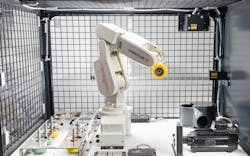Top Industrial Machine Vision Applications
With all the embedded chip and software advances being made to machine vision systems, potential applications of the technology are expanding. Though some of the following applications cited by IoT Analytics (a provider of market insights and business intelligence) are not necessarily “new,” the incorporation of advanced technologies into machine vision is changing how these machine tasks are handled for the better.
Flaw detection
Though machine vision systems have long been used to detect flaws more reliably and faster than human inspectors, the addition of artificial intelligence (AI) to vision systems has dramatically improved speed and accuracy. As noted by IoT Analytics, “non-AI machine vision requires a database with images of all possible flaws for the system to successfully recognize a defect.” However, AI-based vision systems can “discern that something is ‘off’ without requiring specific images for that defect.
IoT Analytics offered an example of how this works by referencing Fujitsu’s use of AI-powered machine vision in its electronics manufacturing plant in Nagano, Japan. Fujitsu says it achieved a 25% reduction in the number of hours required to inspect printed circuit boards by training AI to generate normal images developed by repairing abnormal areas in thousands of simulated images with defects in shape, size and color. To do this, Fujitsu started with images that had no defects. Then, simulated defects were added to these images.
The AI was then trained to remove that defect and restore the image to its original form. According to IoT Analytics, the accuracy is “measured by comparing the initial and restored image. This way, when the AI is less accurate with a particular type of anomaly…it helps precisely target and improve the AI’s weaknesses.”
Contaminant or missing component identification
Quality inspection using AI-driven machine vision technology is not isolated to the identification of good or bad parts. It can also be used to detect food contaminants. Here, IoT Analytics says AI can detect discolorations, foreign objects and other such abnormalities in processed foods.
This technology is being deployed by frozen food company Apetito as part of an automated qualitative assessment system for more than 20 production lines. Apetito is using the technology to ensure its processed foods division can successfully detect all contaminants in the raw ingredients.
Working with AI technology supplier Neurala, Apetito has built 30 AI “brains” to detect various food components used in its food trays. For example, one “brain” was developed to identify missing Yorkshire pudding components. According to Apetito, it achieved 100% accuracy by the end of testing, ensuring that missing components can be detected without fail.
Robot optimization
While quality inspection applications have been a top application in AI-powered machine vision for a few years now, another application involves using the technology to help robots perform more complicated tasks with greater precision.
Designed for Düspohl, a German manufacturer of wrapping machines, the RoboGrinder was built to grind the material used for Düspohl’s roller mechanisms. The Frauenhofer Institute says “the material of the [wrapping machines’] roller is so elastic that it bounces back after grinding, [making it] very difficult to model and integrate into a control technology approach.” Using the RoboGrinder helped Düspohl eliminate 40% of the rubber grinding process.
Pallet dimensioning
Using 3D time-of-flight camera technology, vision systems can now measure the dimensions of loaded pallets to eliminate manual measurement-taking steps and avoid unexpected charges from carriers resulting from inaccurate dimensional weights.
Portugal-based product packaging company DS Smith partnered with machine vision company Neadvance and sensor supplier Sick to develop a pallet dimensioning system. According to IoT Analytics, a camera is mounted at the end of the production conveyor belt to capture a 3D snapshot of all pallets before they are moved. These snapshots provide the data needed to provide the dimensions and volumetric load of pallets.
A significant benefit of this system is that DS Smith’s production process did not have to be changed, as the dimensions of the produced goods are captured and the volume calculated in process using Neadvance Edge software. The Visionary-T Mini 2D image data is then used for subsequent quality monitoring and plausibility checks in the event of error or process analytics.
“With 3D snapshot camera technology, Visionary-T Mini is able to create three-dimensional images of a scene without any moving parts in the device or movement of the sensor itself”, says Anatoly Sherman, head of the 3D Compact Systems business unit at Sick. “The distance data for each pixel is calculated very quickly at a high repetition rate, meaning that the occurrence of blurring effects and motion blur can be prevented.”
Jose Pedro Ferreira, head of business development and sales at Neadvance, says, “The intelligent image processing with the capability of combining the 3D and 2D data is the key to solving the application in a reliable way.”
About the Author
David Greenfield, editor in chief
Editor in Chief

Leaders relevant to this article:

